Corte Main Sights
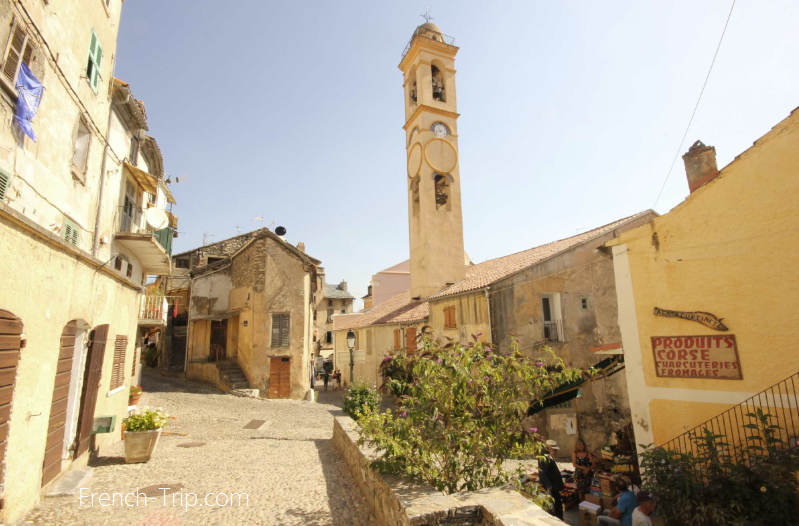
Positioned between granite massifs and schist alpine belts, Corte provides a natural fortress setting that captures both historical intrigue and rugged natural beauty. Its central location on the island makes it an ideal starting point for exploring Corsica’s diverse landscapes.
As the former capital of Corsica’s independent nation in the 18th century, Corte boasts a rich history reflected in its architecture and landmarks. The Citadel of Corte, a prominent historical fortress, provides panoramic views of the surrounding valleys and is a must-visit for history enthusiasts. The Regional Anthropology Museum of Corsica offers deep insights into the island’s culture and heritage. Visitors can explore exhibits that highlight Corsican traditions, art, and history.
The town itself is a delight to wander through, with its quaint streets, vibrant local markets, and traditional Corsican architecture. The Chapel of Sainte-Croix, with its beautifully decorated interior, adds to the town’s cultural allure.
Corte Main Sights
Corte main sights can be easily seen in half a day if you walk around the city center. And, of course, the symbol of Corte and the most striking landmark of the city is its citadel:
Citadel of Corte
The main attraction of Corte is its citadel, nicknamed “the eagle’s nest”. Of the 6 Corsican citadels (for example, Bonifacio, Ajaccio or Calvi), only the citadel of Corte is located inland.
Its construction began in 1419 under the direction of the governor of Corsica, appointed by the King of Aragon, Vicentello of Istria. The purpose of the construction was to fight the Republic of Genoa for the Kingdom of Aragon. Between 1421 and 1434, he ruled northern Corsica and established the seat of his government in Corte.
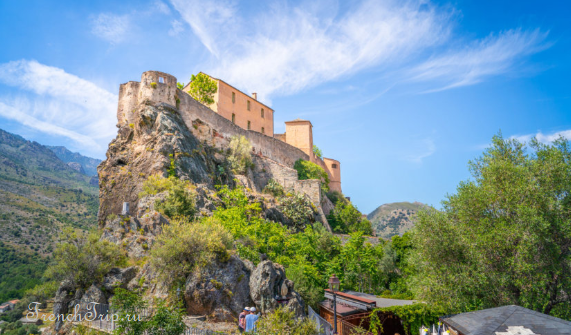
Modifications
The citadel subsequently underwent several modifications over the centuries and was successively occupied by Corsican lords, Genoese and French. The military buildings served as barracks and also prisons, especially during World War II, where many staunch corsairs were imprisoned.
In the 18th century, General Pascal Paoli made Corte the capital of his government. In 1769, after the defeat of the Corsican troops at the Battle of Ponte Novo against King Louis XV, Corsica fell under French rule. Then the Count of Vaux gave the order to increase the city’s fortifications by building the current citadel on the principle of Vauban’s fortifications and constructions (the only citadel among the six Corsican citadels to be built inland). The construction of the Padoue barracks was completed in 1776.
Between 1962 and 1983 the citadel was occupied by the Foreign Legion.
In 1984 the citadel was opened to the public. It offers an exceptional panoramic view of the Restonica and Tavignano valleys.
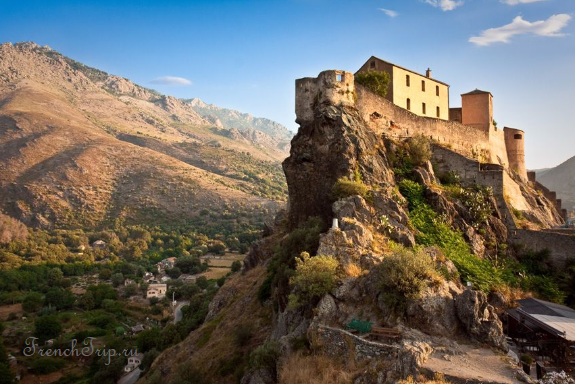
The Castle
The castle in the citadel contains:
- The Corsica Museum (Museum of Art and History and the Corsican Museum of Anthropology).
- The Regional Foundation for Contemporary Art of Corsica (FRACORSE)
- The Scientific and Technical Culture Centre of Corsica (CCSTI)
- The Centru Di Corsica Tourist Office.
- Today the citadel is classified as a historical monument.
Tip: It is at the citadel level that you will find the Corte Tourist Office, where you can pick up a map of the city. The historical heritage tour allows you to see the main historical buildings.
They also organize tours of the Old Town and sell maps with detailed walking routes around Corte. Also at this level, the little train from Corte leaves for a 40-minute tour of the old town.
Regional Museum of Anthropology of Corsica
Le musée régional d’Anthropologie de la Corse. If you want to better understand this amazing island and its culture, a visit to the Museum of Anthropology of Corsica, located right in the citadel, in the Serrurier barracks, is highly recommended.
The collections of the Museum of Corsica are divided into 3 areas:
- The Doazan Gallery, which brings together about 3,000 objects of traditional Corsica, representing the lifestyle of the inhabitants in the mid-twentieth century.
- The “Museum in the Making” Gallery on the social, economic and cultural aspects of Corsica today. The main themes are the development of tourism and the industrialization of the island.
- A temporary exhibition space that presents only one large exhibition per year.
The entrance ticket to the museum also allows you to visit the citadel of Corte and enter the “eagle’s nest”, from where you can enjoy a beautiful view.
There is a paid car park next to the museum.
Belvedere of Corte
When staying in Corte, do not miss the belvedere.
It is located on the left, before entering the citadel, and offers the best view of the “eagle’s nest”. Situated on a promontory overlooking the city, it also allows you to see a 360 ° panorama of the Restonica Valley and Tavignano.
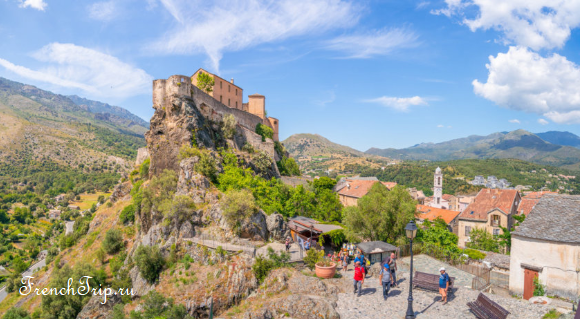
Place Gaffory
This square is home to Maison Gaffory, the birthplace of Jean-Pierre Gaffory, the leader of the Corsican nationalist government in the mid-18th century. He led a revolution against the Genoese before being assassinated. The wall of the house is pockmarked with bullet holes, thought to be caused by an early battle for independence against the Genoese.
A statue of General Jean-Pierre Gaffory, located in Place Gaffory in the old town, at the foot of the ramparts. This bronze sculpture on a marble base, the work of Jean-Pierre-Victor Huguenin, dates from 1900.
Also just above Place Gaffory:
The National Palace, seat of the central government of Corsica and the residence of Pascal Paoli, Gaffory’s successor.
Church of the Annunciation of Corte
The Church of the Annunciation of Corte, built in the Baroque style in the 15th century, is a classified historical monument.
Built between 1450 and 1459, this church was founded in what is now Old Corte by Monsignor Ambroise Arrighi, Bishop of Aleria Ambrogio d’Omessa, between 1412 and 1464. In 1655 it was modified and enlarged. The chapels on the west side were demolished and replaced by a side nave that surrounds the old bell tower in the new building. Notable is the side chapel of San Tefalù with the figure of Blaise de Signori, a Franciscan brother considered the only Corsican saint recognized as the patron saint of Corsica.
The church has an 18th-century organ that has been classified as a historical monument.
A statue and painting of San Tefalù interceding for his countrymen with the Duke of Württemberg, donated by the Vatican, adorn the chapel of San Tefalù.
The painting dates back to 1930 and was bequeathed to Corsica by Pope Pius XI. Originally housed in the Cathedral of Ajaccio, it was donated by the city of Ajaccio in 1974.
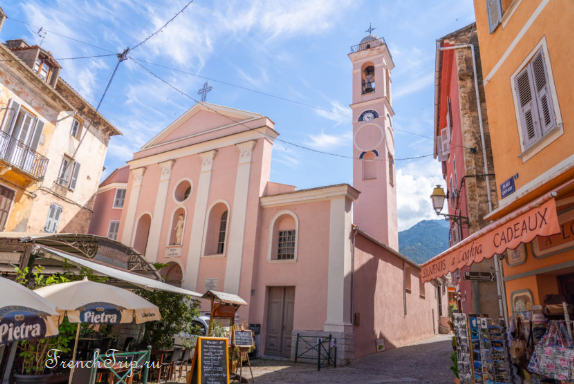
Maison Arrighi de Casanova
The Arrighi de Casanova house, rebuilt in 1760 after a fire, is located at 1, Place du Poilu, under the ramparts of the citadel, near the main entrance door. The parents of Napoleon I lived here in 1768. That year, on January 7, Joseph Bonaparte was born. Ten years later, on March 8, 1778, Jean-Thomas Arrighi de Casanova, Duke of Padua, was born here. A plaque above the entrance door commemorates this event.
The house is listed as a historical monument.

Fountain of the 4 Cannons
The Fountain of the 4 Cannons is located near the place Gaffory, on the congress of Commander Ignace Monteil. This pyramid-shaped fountain was built at the same time as the citadel walls.
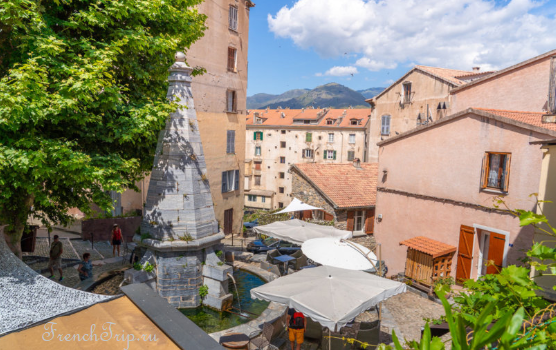
Cours Paoli
This is the main shopping street in the city and, as such, the liveliest, lined with numerous restaurants, shops, cafes, and bakeries. It stretches from Piazza Duca de Padua to Piazza Paoli, where you’ll find a statue of Pasquale Paoli, a celebrated Corsican figure and hero known for his fight for the island’s independence.
Throughout your visit to Corsica, you’ll undoubtedly hear about Paoli, often referred to as “the father of the fatherland.” His legacy is so significant that many village squares are named after him. Recognized as a pioneer of democracy in Europe and a defender of people’s sovereignty, Paoli also established the University of Corte, the only university on the island, which continues to thrive today.
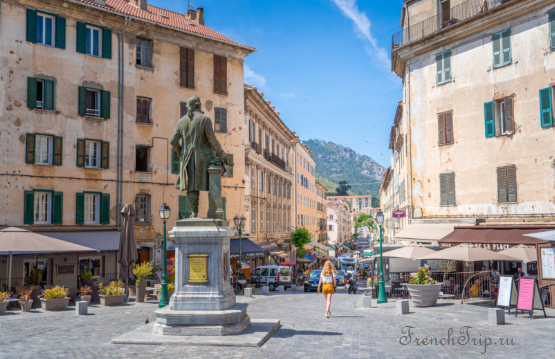
Chapelle Sainte-Croix
You could almost pass by without noticing it, as the exterior of the Chapelle Sainte-Croix is very plain. And yet, the interior of this 17th-century chapel is quite interesting: inside you can see a beautiful Baroque altar and an interesting trompe l’oeil ceiling. Recently restored, it is listed as a historical monument.
The former chapel of the brotherhood, dating from 1634, is located under the citadel, on the corner of rue du Colonel-Feracci and the rampe Sainte-Croix, at the top of the steps from the Cours Paoli, from the fountain rampe Sainte-Croix, also known as the “fontaine du cours”.
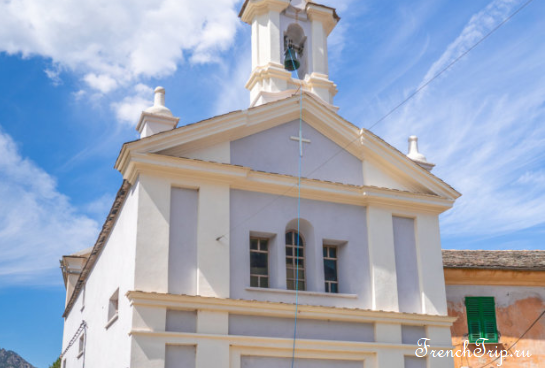
Grocery shop
Corte is home to one of the oldest shops in Europe. Ghionga Grocery dates back to 1769. It offers a wide range of products, but especially good traditional Corsican products: cheeses, delicatessen, liqueurs, jams…
The shop is located at 9 rue du Vieux Marché. It is easily recognizable by its orange façade and green canopy with the inscription “Corsic Products” (Produits corses).
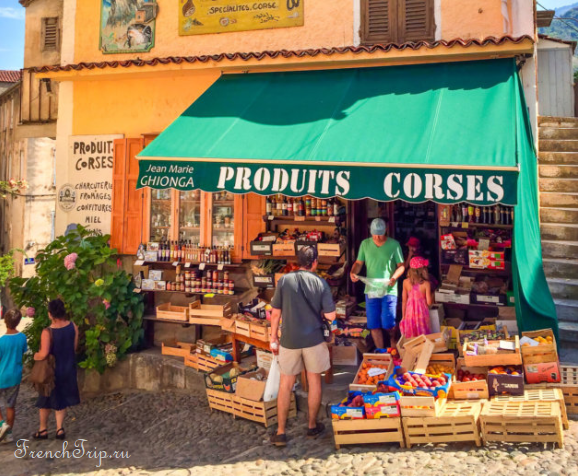
The house known as the National Palace
 Palais National. Built in the 16th and first half of the 17th century, the Palazzu Naziunale was the seat of the institutions of the ephemeral Corsican state from 1755 to 1768.
Palais National. Built in the 16th and first half of the 17th century, the Palazzu Naziunale was the seat of the institutions of the ephemeral Corsican state from 1755 to 1768.
It is a building full of symbols (the government met there), a throne in the heart of the citadel of Corte.
It was a school (formerly the College of Paoli) that was closed in 1921. Abandoned, it became a mobilization center until 1940, then a military and coordination center from 1944 to 1945. Then from 1952 to 1954, the premises will be occupied by the musical company “La Cortenaise“, and on April 27, 1952, the municipal library was opened and finally the Museum of the History of Corsica. Forty-eight of the fifty paintings that are the legacy of Cardinal Fesch in Corte are exhibited here, as well as various documents relating to the history of Corsica.
The building is listed as a historical monument.
Église San Giovanni Battista de Corte
This is a religious complex consisting of a pre-Romanesque church from the 10th century and a baptistery from the 13th century, classified as a historical monument.
The church of San Giovanni Battista, founded a long time ago, is only partially preserved. It is located in the “San Giovanni” area in the southeast of the city, near the sports field.
Next to the church there is a separate baptistery, was it built in the 5th century on the site of a Roman city, ancient Venetium, as some people think?

Architecture
Only the apse remains of the church. Excavations in 1956-1958 managed to renew the foundations of the walls and confirm that the church plan consisted of three naves separated by two rows of square pillars. In the central nave, the remains of archaic liturgical positions are visible: behind the altar are the first steps of the pulpit, a small chair for preaching, similar to those found in paleochristian basilicas. It is the decoration of the apse that allows, by analogy with the decoration of the Lombard churches of northern Italy, to date this pre-Romanesque church to approximately the 9th or 10th century.
As for the baptistery, it is better preserved than the church.
Since 2007, every May, the Portuguese community of Corsica meets on the site of the church of Saint-Jean to spend a whole weekend honoring the memory of their patron saint, Our Lady of Fatima (Notre-Dame de Fátima). Volunteers from the Portuguese association decorate the baptistery and the Way of the Cross. The procession carries a sculpture of Our Lady of Fatima, and then a service is held with a Portuguese choir singing.

Pieve Santa Mariona di Talcini
Pieve Santa Mariona di Talcini is a medieval religious building, now partially ruined. Pieve were the name given to rural churches with a baptistery in the Middle Ages, in contrast to ordinary churches without a baptistery. The Italian word pieve comes from the Latin plebs, which after the spread of Christianity in Italy was applied to the community of baptized people. Many pieve began to appear in the 5th century, when Christianity spread to the countryside outside the main cities. In the 9th and 10th centuries, they were often designed with bell towers.
Located in the heart of the former diocese of Aleria, north of the present city of Corte, isolated on the southern flank of Serra Avena, this church was probably built in the 11th and 11th centuries by Corsican craftsmen. The church is in poor condition: only two double apses and the perimeter of its stone walls are still visible.
The church has a very simple plan, the modest dimensions of which are 14.30 m by 6.80 m wide, and its foundations are directly on the rock. Like most medieval pieas, the church is oriented to the east. It consists of a single nave, extended by two semicircular double apses. Each of the two apses had a large window. The unique tympanum, occupying the two apses, has almost completely disappeared. The church was covered with a gable roof, the arch was almost never used in Corsican medieval buildings. There were two entrances: one in the center of the façade, about 1.40 m wide, the other at the southern wall, at the height of the choir, 1.00 m wide.
→ Back to the Corte travel guide
Archives
Calendar
| M | T | W | T | F | S | S |
|---|---|---|---|---|---|---|
| 1 | 2 | 3 | 4 | 5 | 6 | 7 |
| 8 | 9 | 10 | 11 | 12 | 13 | 14 |
| 15 | 16 | 17 | 18 | 19 | 20 | 21 |
| 22 | 23 | 24 | 25 | 26 | 27 | 28 |
| 29 | 30 | 31 | ||||